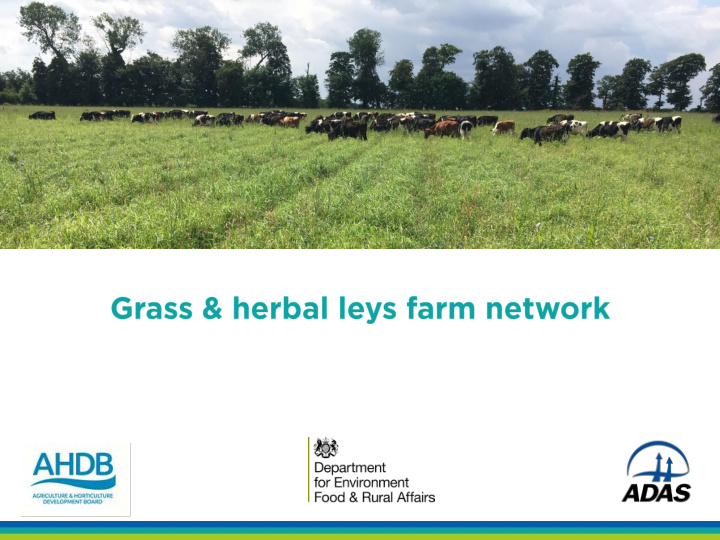



St Paul’s Walden Estate • 2,000 acres • 150 sucklers plus followers • 900 acres arable contract-farmed • 500 acres woodland • Let houses • Commercial & office lets • Boreholes for drinking water • Photovoltaic • Shoot • Sawmill & wood drying kiln
Nuffield Scholarship – Part 1 Groundswell 2017
N American mob graziers
Nuffield Scholarship – Part 2 Groundswell 2017
S American mixed farmers Groundswell 2017
Difference between a Grass & a Herbal Ley • Grass Ley: Usually Ryegrass • Herbal Ley: Many different & Clover broadleaf and grass varieties
Why We Farm 6CO 2 + 6H 2 O C 6 H 12 O 6 + 6O 2
Photosynthesis Equation Carbon Dioxide Glucose + + (Sunlight Energy) Water Oxygen Sun’s energy is captured and locked into the glucose molecule
Releasing the Sun’s Energy
10 12 14 0 2 4 6 8 Capturing the sun Jan Feb Mar Apr May Jun Jul Aug Sep Oct Nov Dec
10 12 14 0 2 4 6 8 Capturing the sun Jan Feb Mar Apr May Jun Jul Aug Sep Oct Nov Dec
Soil OM is captured sunlight
Why herbal leys rather than grass leys? Above Ground: • Improved capture of sunlight • More diverse & balanced diet for livestock – Anthelmintic & other properties • Wider growing window & more balanced growth curve – At either end of the season – During the heat of summer • Species self-select for different soil types • Naturally controls many arable weeds eg blackgrass
Why herbal leys rather than grass leys? Below Ground: • Different rooting depths – Reduces competition for water – larger volume of soil – Pulls nutrients to the surface from a greater depth of soil • More organic matter at varying depths means soil improves more quickly = FERTILITY!
Plants for Soil Fertility
Incorporating leys into an arable rotation • Where to locate the ley? – Infrastructure: Fencing, water, access, handling pens etc – Weed control: eg blackgrass infestation etc – Term of ley: what is length of arable rotation? How will it fit in? What crop should follow the ley?
Choice of plant species • Cool season & warm season grasses & broadleaves • What is suited to your local climate & soil types? • How are you planning to use the ley? • Use seedsman for advice
Plant Groups Cool Season Grasses Cool Season Broadleaves Barley Lentil Rye Pea Wheat Forage Radish Triticale Sweet clover Cocksfoot Chicory Warm Season Grasses Warm Season Broadleaves Maize Buckwheat Sorgum Hairy Vetch Sudangrass Sunflower Cowpea
Establishment • Straight after harvest (as per OSR) works best in my experience – Soil still warm – Usually some moisture – Plants establish before winter and allows earlier grazing in spring • Plough, or Direct Drill, or Broadcast? – Retention of soil structure is key – Aim for maximum soil coverage – Drill larger & broadcast smaller? • Rolling is essential, especially if ploughing, to reconsolidate
Wet weather – new leys Groundswell 2017
Establishment (continued) • Canvassed the opinions of Biodrill other farmers: – d/d westerwolds or festoliums for 1 year ley – Biodrill mounted to rolls – d/d straight into stubbles – Broadcast into standing crop – Undersow spring oats using Einbock Einbock, then roll
Utilising the ley • Grazing • Silage • Hay
Utilising the ley • Grazing – Requires suitable infrastructure: Fences, water, handling facilities
Fencing ideas – arable land
Water Options • Permanent mains-fed supply • Water bowser • Temporary overground pipes • Water pump and temporary trough Groundswell 2017
Water Groundswell 2017
Utilising the Ley • Silage – Do you have a use for it? – Alternatively, do you have a ready market locally (costly to transport)
Utilising the Ley • Hay / haylage – Specialist area, especially if trying to enter the horse market – Difficulties in making hay if using multi-species herbal leys – Storage required (hay) and possible issues with rodents (haylage)
How To Become A Mixed Farm What you need: Access to Capital Land investment Livestock Farmer
How To Become A Mixed Farm Livestock Farmer • Neighbouring Farmer • Farmer’s Son • New Entrant / College Leaver • Grazing management company
How To Become A Mixed Farm Access to Land • Change in Rotations – More cover crops / More spring cropping – 4/5 year grass / forage leys • Land tenure – Grazing licence / share farming / FBT / Other
How To Become A Mixed Farm Capital investment • Landowner • Existing Livestock Farmers • Private Individual • ‘Green’ Investment Funds
Destroying the crop • Chemical – eg spray off with dessicant • Mechanical – eg plough & power harrow • Alternatives? – Heavy grazing / stubble turnips followed by shallow cultivation in spring
Establish the following crop • Concern over frit fly and leatherjacket damage esp after grass ley
Establish the following crop • Should a grass ley be followed by a legume crop to ‘clean’ the ground? • Conversely, a herbal ley may have more broadleaf volunteers in the following crop so would a cereal be a better option? • Work required on savings: fertiliser; herbicides etc for crops following herbal ley
Soil Crop Health Timeline
The Golden Rules 1. Always keep soil covered 2. Try to keep a growing crop in the ground at all times 3. Grow a mixture of plant types through the year 4. Do not cultivate or disturb the soil 5. Include grazing livestock in your rotations
Heifers Grazing Cocktail-Mix Ley
Heifers Grazing Cocktail-Mix Ley Lucerne Cocksfoot Chicory Timothy Red & white clovers Sweet clover Birdsfoot trefoil Sainfoin Plus: Peas, forage rape, stubble turnips, maize, sunflowers, wheat and forage rye
Recommend
More recommend